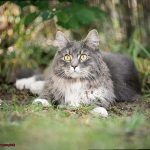Have you ever seen a Maine Coon cat up close? These gentle giants are known for their stunning looks and exceptional size, and their enormous paws are no exception. While most cats have delicate paws, Maine Coon cats have paws that are as big as a human hand.
But why are these paws so significant? What makes them unique, and what functions do they serve? As a cat lover or simply someone intrigued by the incredible world of felines, you may be curious about the anatomy and significance of Maine Coon paws.
In this blog post, we’ll explore these questions in detail. We’ll take an in-depth look at how vital these paws are to the magnificent breed’s overall appearance and abilities. From their impressive size to their strength and dexterity, we’ll uncover what makes Maine Coon paws stand out from the rest.
So get ready to dive into the fascinating world of Maine Coon paws with us. By the end of this post, you’ll be amazed at just how important these massive paws are to one of the world’s most beloved cat breeds.
The Average Size of Maine Coon Paws
When it comes to Maine Coon cats, their impressive size and unique features are hard to miss. One of the most striking characteristics of these “gentle giants” is their paws. These large and sturdy appendages are critical to the breed’s agility and hunting prowess. But just how big are Maine Coon paws, and what makes them so special? Let’s take a closer look.
On average, Maine Coon paws can measure up to 2 inches in width and 4 inches in length. This size allows them to navigate rugged terrain with ease and hunt prey with precision. Interestingly, the front paws of a Maine Coon tend to be slightly larger than the hind paws, which helps with balance and stability. However, the size of a Maine Coon’s paws can vary depending on several factors.
Firstly, gender plays a role in determining paw size. Male Maine Coons tend to have larger and more muscular paws than females, which can help them defend their territory and catch prey more effectively. Secondly, age is another factor that affects paw size. Kittens will have smaller paws that gradually grow as they mature into adult cats. Lastly, genetics can also influence the size of a Maine Coon’s paws, as some bloodlines may produce cats with larger or smaller paws than others.

Despite their massive size, Maine Coon cats are still incredibly agile and graceful thanks, in part, to their impressive paws. Their paw pads are larger and more cushioned than those of other cats, which allows them to land softly and absorb shock when jumping from high places. The tufts of fur between their toes also provide extra traction on slippery surfaces.
Another fascinating feature of Maine Coon paws is polydactylism; this means they have extra toes on their front or hind feet, giving their paws an even larger appearance. While not all Maine Coons are polydactyl, it is a common trait in the breed and can occur in up to 40% of Maine Coon cats.
Polydactylism in Maine Coons
If so, you may know that this breed has a unique genetic trait known as polydactylism, which causes cats to have extra toes on their paws. This trait is believed to have originated from the breed’s seafaring ancestors who used their large paws to navigate rough waters.
Maine Coons with polydactylism can have up to seven toes on each paw, giving them an advantage in hunting and climbing due to increased stability and grip. However, these extra toes can also trap dirt and debris more easily, making paw hygiene a crucial aspect of caring for polydactyl Maine Coons.
While some cat associations do not allow polydactyl cats to compete in shows, many breeders embrace the trait as part of the breed’s unique characteristics. It’s important for owners interested in showing their Maine Coons to check with their specific association’s rules before entering their cat.
Overall, polydactylism is an interesting and unique trait that adds to the charm and abilities of Maine Coons. Here are some key takeaways:
Gender Differences in Paw Size
Maine Coon cats are known for their large size and their paws are no exception. However, when it comes to gender differences in paw size, there are some noticeable variations worth exploring. Male Maine Coon cats tend to have larger paws than their female counterparts. This is because males are generally larger overall, with longer and taller bodies that require more support from their paws.
In fact, male Maine Coon paws can be up to 1 inch larger in diameter than females. While this may not seem like a significant difference at first glance, side-by-side comparison can reveal a striking contrast. Furthermore, male Maine Coons may also have more fur and padding on the bottom of their feet, which can make them appear even larger. This extra fur and padding might give male Maine Coons an edge when it comes to hunting and climbing.
It’s important to keep in mind that individual cats can vary greatly in paw size regardless of gender. Factors such as genetics, diet, and exercise can all play a role in determining the size of a cat’s paws. So don’t be surprised if you come across a female Maine Coon with larger paws than a male.
Despite these variations, it’s safe to say that Maine Coon cats have impressively large paws that are well-suited for their large size. Their sturdy builds and powerful paws serve as excellent tools for hunting and playing. In fact, here are some interesting facts about Maine Coon paws:
- Maine Coon paws are often described as “snowshoe-like” due to their large size and tufted toes.
- The extra fur on the bottom of their feet helps them to navigate through snow and other rough terrain.
- Maine Coons can use their paws to pick up and manipulate objects, almost like hands.
Benefits of Large Paws for Hunting and Navigation
These mighty appendages offer a host of benefits, particularly when it comes to hunting and navigation. Originally bred as working cats on farms and ships, these traits were highly valued in their line of work.
One of the most significant advantages of having large paws is the ability to navigate rough terrain and hunt prey more effectively. These furry giants distribute their weight evenly, providing them with better balance and stability when scaling trees, dashing across landscapes, or pouncing on unsuspecting prey. Their large paws make them excellent hunters, enabling them to catch prey with precision and ease.
Beyond hunting, Maine Coons have an innate sense of navigation. Their large paws help them feel the ground beneath them more accurately, allowing them to navigate their environment with greater ease. They can sense vibrations and changes in texture, which helps them find their way around even in low-light conditions or unfamiliar territory.
The size of Maine Coon paws also plays a crucial role in their love of swimming. These feline water enthusiasts can paddle with ease thanks to their large paws, which provide them with better traction in the water. With extra surface area at their disposal, they can maneuver and swim quickly.
Tufts of Fur for Added Warmth and Traction
Maine Coon cats are a remarkable breed, known for their majestic appearance and unique physical characteristics. One of the most fascinating features of these furry giants is their specially designed paws, which are perfectly adapted to help them survive in cold climates.
The tufts of fur between their toes are a standout feature that serve multiple purposes. Firstly, these tufts of fur act as insulation, providing added warmth and protection to their feet from the cold ground. Maine Coons are no strangers to harsh winter weather, but with these natural boots, they can confidently enjoy their outdoor adventures without worrying about frostbite.
Secondly, the tufts of fur provide added traction and grip, allowing them to walk on slippery surfaces with ease. Walking on an icy surface without slipping is a reality for Maine Coons thanks to their incredible paw design.
But it’s not just the tufts of fur that make Maine Coon paws unique. Their overall size is significantly larger than other domestic cat breeds, with paws that can measure up to two inches wide and four inches long. This size is well-suited for their outdoor lifestyle, enabling them to easily navigate rough terrain and climb trees like no other cat.
Furthermore, Maine Coons are polydactyl, meaning they have extra toes on their paws. This feature provides even more stability and balance, making them excellent climbers and hunters. The extra toes also contribute to the overall size of their paws, making them appear even larger than they already are.
How to Measure the Size of a Maine Coon’s Paw
Fortunately, it’s a simple process that requires only a few tools and techniques. Here are five sub-sections to help you get an accurate measurement:
Gather Your Tools and Choose a Calm Space
Before you begin measuring your cat’s paws, gather your tools. You’ll need a ruler or measuring tape and some treats or toys to keep your cat still during the process. Once you have everything you need, choose a quiet and comfortable space for your cat. Make sure there are no distractions or stressful elements that could make the process more difficult.
Measure the Length of Your Cat’s Paws
Gently pick up one of your cat’s paws and extend it fully. Use the ruler or measuring tape to measure the length from the base of the paw to the tip of the longest toe. Repeat this process for each paw, as they may differ in size. Be sure to take note of any extra toes if your cat is polydactyl.
Measure the Width of Your Cat’s Paws
To measure the width of your cat’s paw, place the ruler across the widest part of the paw pad. Again, be sure to measure both paws as they may differ slightly in size.
Understand Paw Size Variations
It’s important to note that a Maine Coon’s paw size can vary depending on their age, gender, and overall size. Male Maine Coons tend to have larger and more muscular paws than females, which can help them defend their territory and hunt prey more effectively.
Use Paw Size Information for Accessories and Growth Potential
Measuring your Maine Coon’s paw size can be valuable when purchasing accessories such as collars or boots. It can also serve as an indicator of their overall size and growth potential. Keep in mind that Maine Coons are known for having larger paws compared to other cat breeds. On average, their paws can range from 3-4 inches in length and 2-3 inches in width. However, some Maine Coons can have paws that are even larger than this.
Potential Health Issues Related to Paw Size
If you’ve ever owned a Maine Coon cat, you know that their large, furry paws are one of their most distinguishing features. These paws are not only adorable but also essential for their survival in the wild. However, as with any physical trait, there can be potential health issues related to paw size that cat owners should be aware of.
One common health issue that Maine Coon cats with large paws may face is arthritis. Due to their size and weight, these cats put significant pressure on their joints, including their feet and paws. Over time, this can cause joint inflammation and pain, making it difficult for them to walk or climb.
Another potential health issue is the development of cysts or tumors on their paws. Maine Coon cats are prone to developing benign tumors called fibromas, which can grow on their paws and cause discomfort or pain. If left untreated, these tumors can become malignant over time.
In addition to these issues, cats with large paws may also be more prone to injuries such as sprains or fractures. Their size and weight can make it more challenging for them to maintain balance and agility, increasing the risk of falls or other accidents that can result in paw injuries.
While these potential health issues may sound daunting, it’s important to remember that not all Maine Coon cats with large paws will develop them. Regular veterinary check-ups and monitoring of your cat’s paw health can help prevent or address any potential issues before they become serious problems.
Tips for Keeping Your Cat’s Paws Healthy
Keeping your cat’s paws healthy is crucial for their overall well-being. Here are some tips that you can follow to ensure your furry friend’s paws stay healthy and pain-free.
Trim Your Cat’s Claws Regularly:
Long claws can be uncomfortable for cats and can even lead to injuries. To prevent this, make sure to trim your cat’s claws every two to three weeks. Using proper nail clippers and being gentle when trimming will avoid hurting them.
Check for Cuts or Scrapes:
Regularly checking your cat’s paws for any cuts, scrapes, or injuries is essential. If you notice any injuries, clean the wound immediately and seek veterinary attention if necessary. This will prevent infections and other complications.
Keep Litter Boxes Clean:
Dirty litter boxes can cause infections and irritations on your cat’s paws. Make sure to scoop the litter daily and replace it entirely at least once a week. Keeping the litter box clean will prevent infections and promote good paw hygiene.
Provide Scratching Posts:
Scratching is a natural behavior for cats, and it helps them shed the outer layer of their claws, keeping them healthy and preventing them from getting too long. Providing your cat with a designated scratching post or pad will prevent them from scratching furniture or other surfaces that could damage their paw pads.
Moisturize Your Cat’s Paws:
Dry and cracked paws can be uncomfortable for cats. Moisturizing your cat’s paws with a small amount of coconut oil or paw balm will keep their paws soft and supple. This will prevent dryness and cracking, keeping their paws healthy.
Conclusion
To sum it up, Maine Coon cats are truly remarkable creatures with their impressive size and striking appearance, and their paws are no exception. These gentle giants have sturdy and sizable paws that are essential to their agility and hunting abilities.
Typically measuring up to 2 inches in width and 4 inches in length, these paws allow them to navigate rough terrains effortlessly while also aiding in precise prey capture. Interestingly, male Maine Coons tend to have more muscular and larger paws than females, giving them an edge when it comes to defending their territory or catching prey.
The design of Maine Coon cats’ paws is fascinating, with polydactylism being a common trait that adds to their charm. The tufts of fur between their toes serve as insulation for added warmth from cold ground while providing extra traction on slippery surfaces. Their overall size is significantly larger than other domestic cat breeds, making them ideal for outdoor activities such as hunting or climbing trees.
It’s essential to keep your cat’s paw health in check for their overall well-being. Regular veterinary check-ups, monitoring your cat’s paw health, trimming claws regularly checking for cuts or scrapes are some tips that will keep your furry friend’s paws healthy and pain-free.
In conclusion, if you’re looking for a feline companion with impressive features like large and robust paws, the Maine Coon cat breed is an excellent choice.







